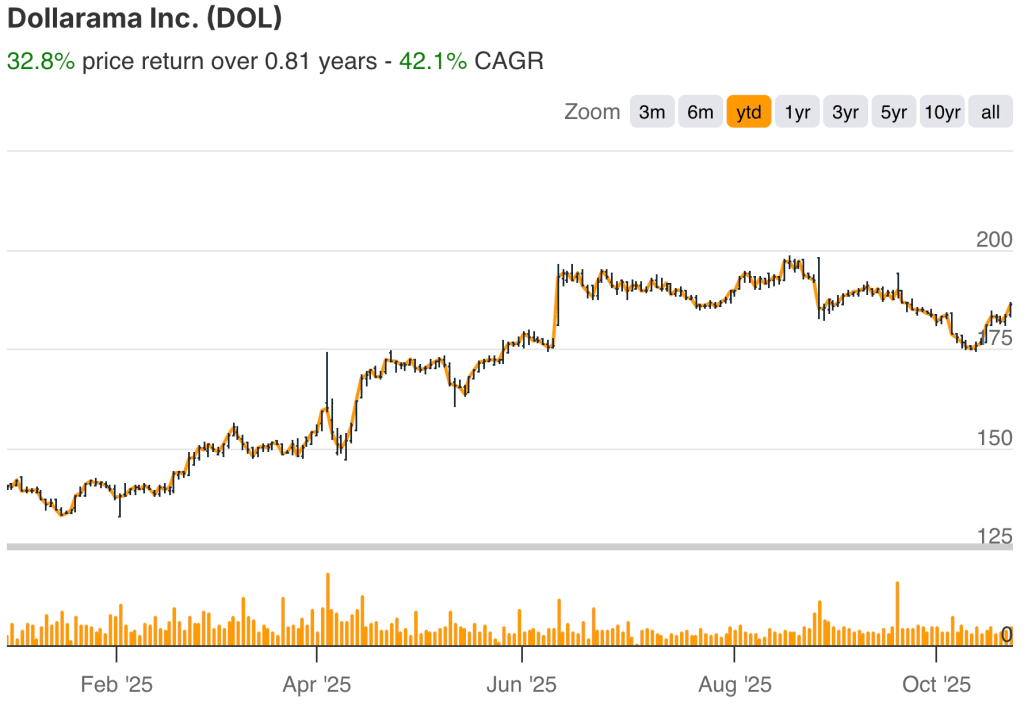Dollarama Inc. (DOL) has evolved from a homegrown Canadian retailer into one of the world’s largest discount chains, now spanning seven countries and 2,718 stores across three continents. Headquartered in Montréal, Dollarama offers fixed low prices on everyday essentials and seasonal goods through an efficient, high-turnover model that caters to value-conscious shoppers in both developed and emerging markets.
Find out what a stock’s really worth in under 60 seconds with TIKR’s new Valuation Model (It’s free)
The company’s second quarter of fiscal 2026 confirmed its momentum. Revenue jumped 10.3% year-over-year to $1.72 billion, supported by a 4.9% same-store sales increase in Canada and the recent acquisition of Australia’s largest discount retailer, The Reject Shop (TRS). With 395 stores in Australia added to its network, Dollarama now operates under two major segments, Canada and Australia, while expanding its presence in Latin America through its majority stake in Dollarcity, which itself saw 16.4% sales growth and opened its first store in Mexico this quarter.

Beyond topline gains, Dollarama continues to prove its operational discipline. EBITDA rose 12.2% to $588.5 million, with margins expanding to 34.1%, even as integration costs from the TRS acquisition began to flow through. Net income climbed 12.4% to $321.5 million, driving a 13.7% jump in EPS to $1.16. As CEO, Neil Rossy put it, this quarter marked “a significant milestone in our international expansion,” one that positions Dollarama for sustained, multi-market growth heading into 2026.
Quickly value any stock with TIKR’s powerful new Valuation Model (It’s free!) >>>
Financial Story
Dollarama’s Q2 results solidified its status as one of Canada’s most consistent growth engines. Double-digit sales and earnings growth reflect both healthy domestic demand and the early impact of its global expansion strategy. While the TRS acquisition in Australia is still in its early integration phase, its contribution to total revenue marks an important step toward diversifying geographic exposure beyond North America.
| Metric | Result | YoY Change | Commentary |
|---|---|---|---|
| Revenue | $1.72B CAD | +10.3% | Driven by 27 new stores and TRS acquisition |
| Comparable Store Sales (Canada) | +4.9% | +20 bps vs FY2025 | Strong demand for consumables |
| EBITDA | $588.5M | +12.2% | Margin of 34.1%, up from 33.5% |
| Operating Income | $483.5M | +14.3% | Reflects cost efficiencies and store leverage |
| Net Income | $321.5M | +12.4% | EPS up 13.7% to $1.16 |
| Gross Margin | 45.5% | +30 bps | Lower logistics costs |
| SG&A | 14.0% of sales | +40 bps | Integration and transaction costs from TRS |
| Store Count | 2,060 | +477 stores YoY | Includes 395 Reject Shop stores |
| Dividend | $0.1058/share | +15% | Next payment Nov 7, 2025 |
The Canadian business remains the cornerstone, accounting for the vast majority of profit, with comparable store sales up 4.9% and margins benefiting from improved supply chain costs. Gross margin reached 45.5%, supported by lower logistics and shipping costs, while EBITDA margins remained firmly above 34%, among the best in Canadian retail. Dollarcity’s growth in Latin America also continues to impress, with strong performance in Colombia, Peru, and Guatemala providing further earnings tailwinds.
Management reaffirmed its fiscal 2026 guidance for Canada, targeting 70–80 new stores, 3–4% comp growth, and gross margins between 44.2% and 45.2%. With cash reserves at $687 million, net debt-to-EBITDA at 2.05x, and a steady cadence of share buybacks and dividends, Dollarama remains a model of balance-sheet strength and operational execution. The key challenge ahead: integrating Australia smoothly while maintaining its disciplined cost structure and pricing power in an inflation-sensitive retail environment.
See Dollarama’s full financial results & estimates (It’s free) >>>
Broader Market Context
Dollarama’s expansion comes as global consumers continue to trade down amid sticky inflation and higher interest rates. The value retail segment, long dominated by chains like Dollar General, B&M, and Pepco, has become one of the few retail categories still growing in volume terms. For Canadian households facing tighter budgets, Dollarama’s low-price, high-turnover model remains particularly compelling.
At the same time, its move into Australia and Latin America positions the company to capture global demand for affordable essentials in markets where value shopping is an emerging cultural norm. With competitors struggling to balance inflation and inventory, Dollarama’s operational simplicity and pricing flexibility stand out. Its success in replicating the Canadian playbook abroad will be key to sustaining double-digit EPS growth.
1. Expanding the Global Footprint
The acquisition of The Reject Shop in Australia marks Dollarama’s first direct operating presence outside the Americas. While TRS’s contribution in Q2 was modest ($25.7 million in sales over 12 days), the move gives Dollarama a platform in a mature, English-speaking market with a similar consumer profile. Management plans to optimize TRS’s sourcing and merchandising, applying its proven procurement model to improve profitability and scale.
Meanwhile, Dollarcity’s growth in Latin America remains a hidden gem in Dollarama’s portfolio. The addition of Mexico as a fourth market extends the growth runway, with 658 total stores now contributing to a 68.9% year-over-year increase in Dollarama’s share of Dollarcity net income. This geographic diversification reduces earnings concentration risk and creates optionality for future IPO or spinoff value.
2. Consistent Profitability Amid Rising Costs
Dollarama’s efficiency remains a benchmark within Canadian retail. Operating margin expanded 100 basis points to 28.0%, even as SG&A rose from TRS transaction costs and integration expenses. The company’s sourcing scale, limited SKUs, and private-label dominance provide structural advantages that protect margins from cost pressures.
Even in a challenging macro environment, Dollarama has consistently delivered double-digit earnings growth, supported by disciplined inventory management and strong supplier relationships. This cost control gives the company flexibility to absorb inflation without passing it fully to consumers, a competitive edge that reinforces brand loyalty.
Value stocks like Dollarama in less than 60 seconds with TIKR (It’s free) >>>
3. Shareholder Alignment and Capital Discipline
Dollarama’s capital allocation playbook remains a standout. The company repurchased 932,000 shares for $174.8 million in Q2 while maintaining a payout ratio near 10%, balancing growth investments with shareholder returns. The quarterly dividend was raised by 15% year over year, reflecting management’s confidence in cash flow stability.
With EBITDA margins above 34%, low leverage, and strong free cash flow generation, Dollarama has ample flexibility to fund expansion while rewarding shareholders. The disciplined approach to debt, especially after a major acquisition, highlights management’s conservative stewardship and long-term focus.
The TIKR Takeaway

Dollarama’s 2025 performance underscores why it remains one of the most reliable compounders on the TSX. The company’s domestic business continues to thrive, and its international expansion into Australia and Latin America signals a thoughtful evolution from national retailer to global value brand. Robust margins, disciplined execution, and consistent capital returns form the backbone of its appeal.
Still, the stock’s rally has priced in much of the optimism. At nearly 30x forward earnings, Dollarama now trades at a premium to global peers such as Dollar Tree and B&M, leaving less room for multiple expansion. Continued earnings growth will need to come from execution, particularly in integrating TRS and scaling Dollarcity profitably, rather than revaluation. Long-term investors can expect steady compounding, but near-term upside may moderate after a stellar year.
Should You Buy, Sell, or Hold Dollarama Stock in 2025?
Dollarama remains one of Canada’s most consistent performers, combining stable domestic growth with a smart, measured push into new markets. The fundamentals are excellent, but the valuation reflects it. Existing holders can remain confidently invested for steady growth and dividends, while new investors may prefer to wait for a pullback to the $105–$110 range before adding exposure.
How Much Upside Does Dollarama Stock Have From Here?
With TIKR’s new Valuation Model tool, you can estimate a stock’s potential share price in under a minute.
All it takes is three simple inputs:
- Revenue Growth
- Operating Margins
- Exit P/E Multiple
If you’re not sure what to enter, TIKR automatically fills in each input using analysts’ consensus estimates, giving you a quick, reliable starting point.
From there, TIKR calculates the potential share price and total returns under Bull, Base, and Bear scenarios so you can quickly see whether a stock looks undervalued or overvalued.
See a stock’s true value in under 60 seconds (Free with TIKR) >>>
Looking for New Opportunities?
- See what stocks billionaire investors are buying so you can follow the smart money.
- Analyze stocks in as little as 5 minutes with TIKR’s all-in-one, easy-to-use platform.
- The more rocks you overturn… the more opportunities you’ll uncover. Search 100K+ global stocks, global top investor holdings, and more with TIKR.
Disclaimer:
Please note that the articles on TIKR are not intended to serve as investment or financial advice from TIKR or our content team, nor are they recommendations to buy or sell any stocks. We create our content based on TIKR Terminal’s investment data and analysts’ estimates. Our analysis might not include recent company news or important updates. TIKR has no position in any stocks mentioned. Thank you for reading, and happy investing!








